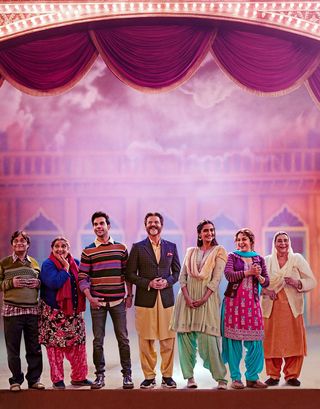Bias
How I Felt When I Saw That Girl
A film by Shelly Chopra Dhar (in Hindi, with English subtitles)
Posted February 10, 2019
How I Felt When I Saw That Girl (Ek Ladki Ko Dekha Toh Aisa Laga)

The opening scene fills the screen with luminous, costumed South Asians in a glittering banquet hall, with pulsing music, big smiles and the joy of an Indian wedding. The wedding guests, of all ages, true to Indian culture, are dancing up a storm. We the viewers are swept into the rhythms and movement—into a moment when all seems good in the world. It’s Bollywood—but way beyond traditional (and constrained) Indian conventions as we discover as the story unfolds.
Law 377 of the Indian Penal Code (introduced in 1864, when under British rule) reads: Unnatural offenses: Whoever voluntarily has carnal intercourse against the order of nature with any man, woman or animal shall be punished with imprisonment for life, or with imprisonment of either description for a term which may extend to ten years, and shall also be liable to fine. In other words, gay sex (and marriage) are against the law.
After a series of fits and starts that legally challenged this discriminatory law, on September 6, 2018, the Indian Supreme Court unanimously ruled that Section 377 was unconstitutional "in so far as it criminalizes consensual sexual conduct between adults of the same sex.” Upon the Court’s ruling, shouts of another form of joy were heard across India and the rest of the world. At least under Indian law, being a lesbian or gay man was no longer illegal. Cultural shifts, however, have a way of not always abiding by changes in the law, or take their time to be absorbed and adopted because hearts, not just laws and minds, must be changed.
How I Felt When I Saw That Girl is principally set in Moga, in the state of Punjab. There by intention, to drive deeper into family and culture outside of the country’s huge and far more westernized cities (like New Delhi or Mumbai). It is in cities (and villages) like Moga where homosexuality often still carries a definition of abnormality, with its agonizing internal state of self-hatred. It continues to stir family confusion and rejection, and ushers in the awful specter of shame for the gay person and her or his family.
To begin to spread cultural change and the acceptance of being queer, I learned, the director (who also co-wrote the script), Shelly Chopra Dhar, has given us this wonderfully heartening—and entertaining—film. If, of course, you have a taste for Bollywood, its great actor stars, and for a film aimed at ending the deadly discrimination that people who love others of the same gender face. Without giving us a “sermon”, as she has said. Ms. Dhar was raised in India, though English is her first language. She has lived in the US for many years, and the gift of film production runs in her family, with her brother, daughter and son in the business, and all quite accomplished. This film is however, Ms. Dhar’s first film of her own, which she has rendered as a masterful storyteller, and visual and musical artist. This film is a pioneering work of art and compassion, tightly woven with the knots of family and culture.
The plot centers around a prosperous, Punjabi merchant, who manufactures women’s clothing and underwear. Anil Kapoor, a huge Indian film star, plays the widowed father, Balbir; he lives with his helicopter-hovering like mother whose mission is to make him manlier, not fussing in the kitchen cooking, as he is wont to do. He has two children, Sweety (Sonam Kapoor; Anil Kapoor is her real-life father), and her older brother, Babloo (Abhishek Duhan), who has the tough job of portraying the discriminatory attitudes and hostile behaviors foisted on gay people.
The plot twists, however, from the start, where we are led to believe that Sweety’s love interest is in a failing playwright, Sahil (Rajkummar Rao), who is Muslim, another source of great troubles in traditional Hindu families. But, this is not your everyday boy meets girl film; it is girl meets girl, and love blossoms film. Just like in nature, even if family and culture decry it a disease and demand its eradication. Sweety loves Kuhu (Regina Cassandra), a more westernized, urban woman who, like Sweety, is irresistible (to a woman or a man).
How I Felt When I Saw That Girl takes us deep into Indian culture, with its long-standing animus to gay people. Though, I thought when watching, my country has far from mastered this problem. Recall, in 2016, 49 people were killed, and 53 injured, in an attack on an Orlando gay nightclub. Many other LGBT people, over many years, have been abused or killed and some have taken their lives after endless cruel bullying and shame. As a westerner, this film offered me a different frame of mind on the problem of, in this case, gay discrimination because it is set culturally apart from my life: while it is emotionally close—because we are all human - this was not quite my family, culture or world. Ms. Dhar’s narrative tale gives us westerners perspective, in a tender way, on the prejudice and intolerance we too face. She does so without vilifying anyone. Instead, she aims to lead us all to acceptance of whatever nature has bestowed upon us, as it exists in those who daily inhabit our lives, at home, work, and in our diverse communities.
There is nothing that can match a parent’s love of a child. It is that blessing, for both parent and child, that carries us to the sweet, but still unsettled, ending of this daring film. This is the first, major, commercial Indian film to unveil romantic love between women, which has, of course, great emotional resonance throughout the globe.


